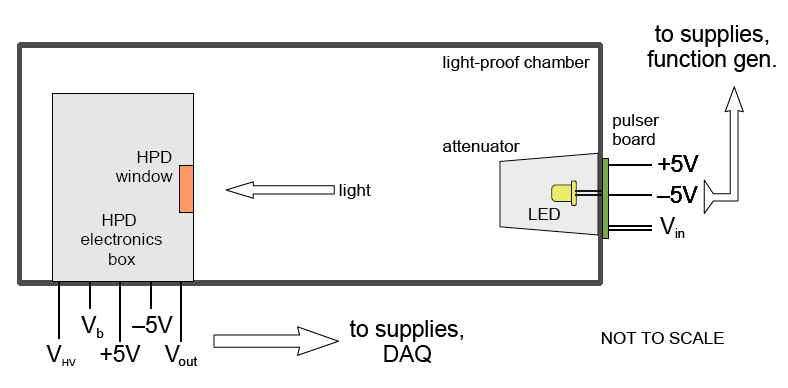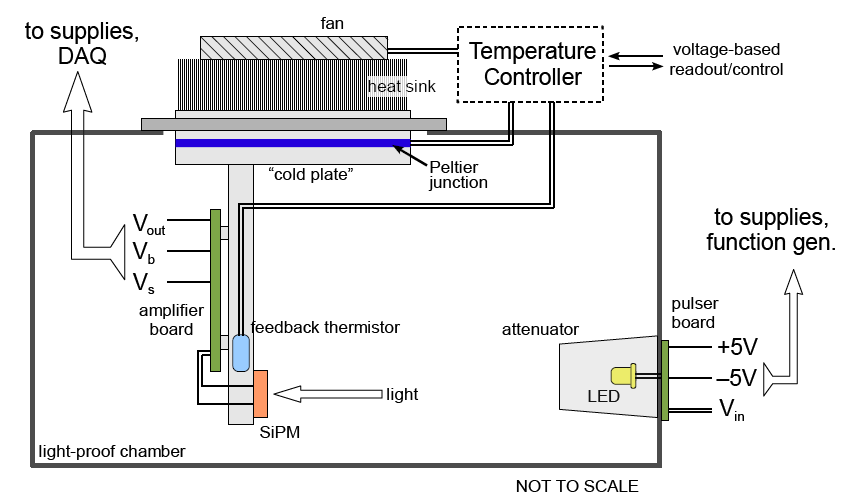Dark chamber
A fast light source operating in an environment with little background is necessary for the tests described here. The challenge is in preventing light leaks in this chamber despite the need for access ports, patching wires through walls and installing sensor and temperature control modules that must interface with the outside. The design, construction, and test of a dark chamber that meets these requirements, as well as approaches to data acquisition are discussed here.
Dark Box Construction
Below are the diagrams of the dark box with the HPD and SiPM assemblies installed. A temperature controller system (TE Tech. TC-24-12) was procured, which operates by driving a Peltier junction based on feedback from a thermistor compared to voltage-specified reference temperature. It was calibrated and installed into the wall of the dark box via a custom-designed light-tight frame.
Light Pulser
A pulser circuit was designed with a pulse height controlled by the amplitude of a step function from a function generator. The pulser differentiates the step function signal and therefore can create pulses as narrow as the rising edge of the step function. Above a saturation point, the pulse broadens to a maximum of 6 ns. The adjacent figure shows the pulser circuit that drives the LED. The LED has some finite rise time and sometimes a very long decay tail. This response function convolves the pulser signal so the speed of the combined system has to be analyzed for each LED type and evaluated for the use of photon detector characterization.
Choice of Light Source
The original LED available to the group was the blue QT Optoelectronics MV5B60. Analyzing the pulses from the HPD illuminated with this device showed an initial spike in its light output followed by a tail with a very long decay constant. Several more devices with longer wavelengths were procured and measured. We settled on a yellow LED (Fairchild MV8304) for subsequent measurements because it had no long tail in its light pulses. The SiPMs were characterized with respect to one another and the HPD using this LED. Its mean wavelength is about 590nm, near the peak of the SiPM photon detection efficiency curve.
By the time more detailed studies of the SSPM-06 were initiated, a fast LED very close the the mean emission wavelength of the BCF-20 was found. This was the Agilent (Avago Technologies) HLMP-CE30-QTC00. Its pulse shows a small tail in the light output that lasts for about 100ns, but this is fast enough to be contained in the 100ns integration gate used for these tests.
Data Acquisition
A Tektronix TDS 2024 (2Gsamp/s, 200MHz) was used to acquire the SiPM signal from its preamplifier. The response of the SiPM preamplier is well understood based on detailed analysis and simulation. Since tens of thousands of waveforms are necessary to construct a clean histogram of collected charge, a fast PC based data collection system was necessary. The data export module installed on this oscilloscope allows RS-232 interface over which commands can be issued and data transfer requested. Unfortunately going above the baud rate of 9600 always resulted in lost bytes. At 9600 the 2500-sample waveform collected by the oscilloscope takes about 2-3 seconds to transfer over the serial link to the host PC. Since we are dealing with time windows of 1μs in which the unit is too slow to collect all 2500 samples (it was found to copy or interpolate between actual samples) it was decided to just collect the first 1000 samples, corresponding to the first 4 divisions on the screen. Under these conditions, the waveforms were collected at a rate of one per second.
For the purposes of collecting integrals of waveforms (proportional to total charge collected per received flash) it was later found that the averages of the functions could be automatically computed by the oscilloscope and then the results transferred much faster than the entire waveform, about 3 per second. This value times the window duration equals the desired integral!
Aside from the convenience of being able to collect usable results within hours instead of a day, this speedup also minimized the problem of systematic drifts that occur during long runs. It was found that the higher statistics obtained during extended runs would sometimes be offset by the blurring of peaks due to slow drifts in the gain and pedestal. Whether due to environmental variations over the course of a day or electronic effects, these drifts smeared the histograms, most of which already had a very faint sign of resolved photon peaks. So, faster data acquisition also meant reducing the effects of these drifts.
Test and Calibration
Background/Consistency Tests
The chamber was checked for leaks using long-exposure photography. It was able to detect minute leakage through seams in the back access port. This problem was fixed to the extent that sensors were no longer sensitive to that level of background. The box was tested with SiPM measurements performed with room lights on and off (which should provide order of magnitude difference of ambient light.)
Although the temperature of the sensor is stabilized (using techniques described above) other sources of of systematic errors were a source of concern. These include changes in pulser input function, pulser LED light output variations etc, amplifier gain and bias voltage shifts etc. To test for these effects, a run of several days was performed and signal histograms of half our slices were compared. Two methods of detection rate measurement yielded only ~2.5% variation. It is interesting to note that a similar such run conducted by accident without temperature control of the sensor yielded ~8.3% variation in detection rate.
Calibration
Running this setup with a hybrid photodiode (HPD) module DEP PP0350 of known characteristics allows us to calibrate the light intensity. The SiPM detection efficiency can then be characterized relative to the HPD. The signal from the SiPM turned out to beclean enough to distinguish peaks corresponding to discrete photon (pixel) counts in the histogram of waveform integrals. Therefore, the gain of the SiPM was found independently of the HPD - the SiPMs were self-calibrating! (The detection efficiency, however still requires knowledge of the photon flux incident on the SiPM window, for which the the HPD is a reference.) The measurements section below describes this feature further.


